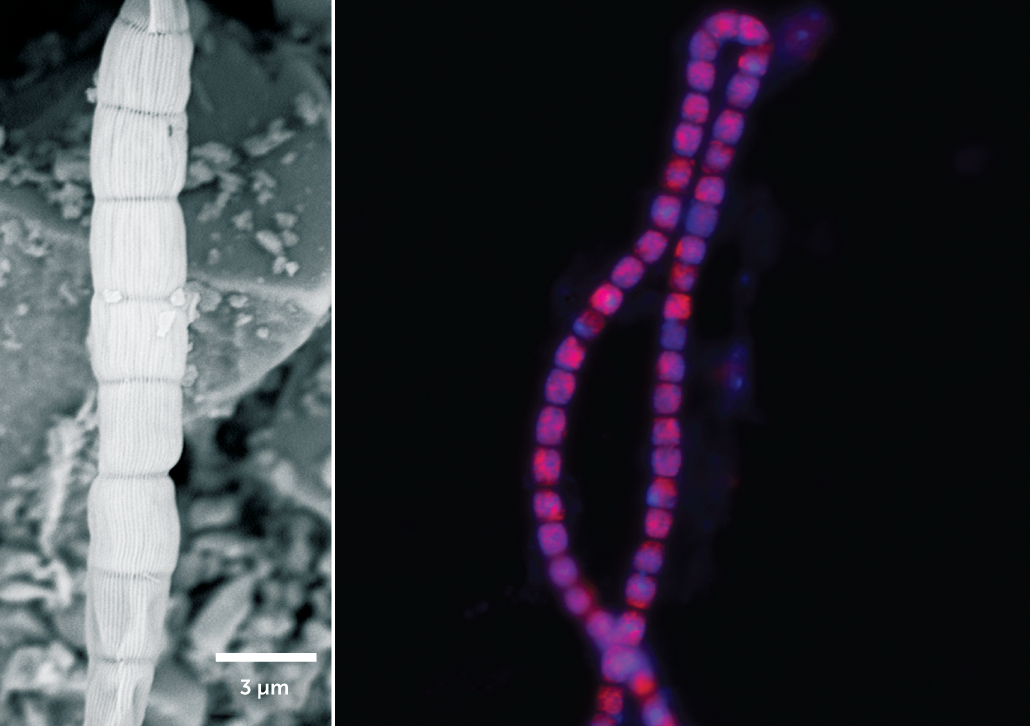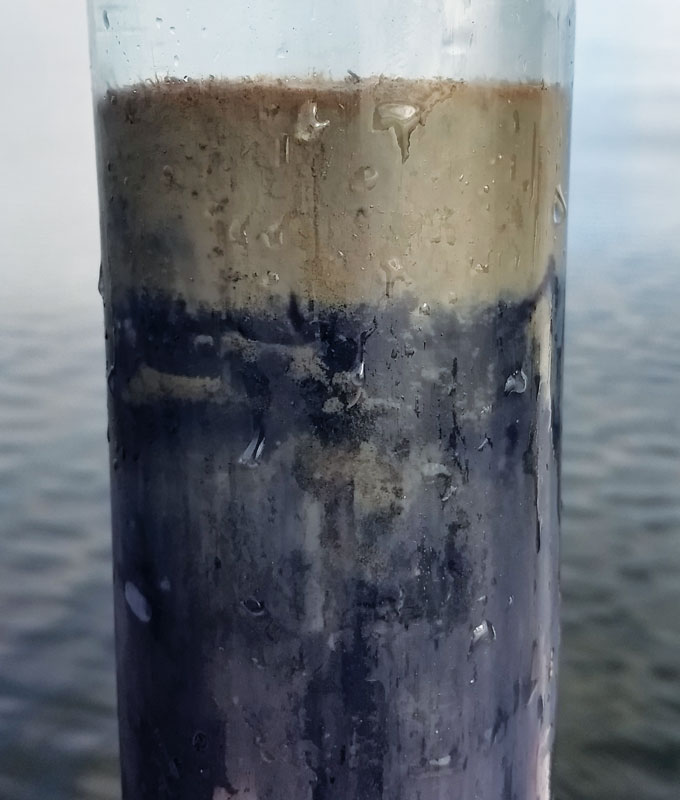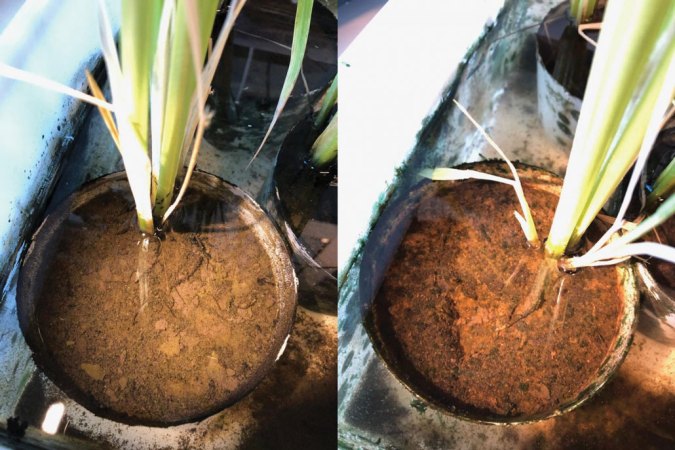Bacterial ‘living wires’ could help protect the seas and climate
A long, thin microbe could help clean up oil spills and reduce emissions of methane

Cable bacteria look like long, thin threads in this microscope image. To help the environment, scientists hope to harness the ability of these microbes to conduct electricity.
Steffen Larsen, Lars Riis Damgaard
Share this:
- Share via email (Opens in new window) Email
- Click to share on Facebook (Opens in new window) Facebook
- Click to share on X (Opens in new window) X
- Click to share on Pinterest (Opens in new window) Pinterest
- Click to share on Reddit (Opens in new window) Reddit
- Share to Google Classroom (Opens in new window) Google Classroom
- Click to print (Opens in new window) Print
By Nikk Ogasa
A small motorboat anchors in the Atlantic Ocean’s Chesapeake Bay. Nearby birds shriek. Their noise assaults the vessel’s five crew members. One of the crew slowly pulls on a rope to haul up a plastic tube. About the length of a person’s arm, this tube is filled with mud from the bottom of the bay. It fills the air with the stench of rotten eggs.
“Chesapeake Bay mud is stinky,” says Sairah Malkin. A biogeochemist, she studies the chemistry that happens when living things meet rocks and soil. She works at the University of Maryland Center for Environmental Science in Cambridge. The mud’s pungent smell comes from chemicals called sulfides. They’re quite toxic, Malkin explains.

She and her team visit the bay every couple of months to sample the foul muck. On each trip, they track squiggling mud-dwellers known as cable bacteria. These long microbes are living wires. Thinner than a human hair, their bodies can channel electricity.
Cable bacteria use that electric power to change their surroundings. In the bay, for example, they can remove those stinky sulfides. That keeps the dangerous chemicals from moving from the mud into the water. This is one way cable bacteria may protect all kinds of sea life from a “toxic nightmare,” says Filip Meysman. He’s a biogeochemist at the University of Antwerp in Belgium. These microbes, he explains, are “kind of like guardian angels in these coastal ecosystems.”
Now, scientists are studying other benefits of these living wires. In lab studies, cable bacteria can support microbes that gobble up crude oil. If researchers can learn how to help the bacteria grow, these microbes might be unleashed to clean up oil spills. Cable bacteria might help tackle another type of pollution, too: the potent greenhouse gas called methane.
Cable bacteria seem to be powerful influencers in their microbial communities. The next step, Meysman says, is to figure out how to channel that power for the greater good.
Electric life
Under the microscope, cable bacteria look like long sausage links. Each bacterium links together many narrow cells. That’s why their bodies can grow to be larger than those of other bacteria. Although they are super-thin, the bacteria can grow up to five centimeters (two inches) long! Each of these cells contains parallel “wires” of proteins that conduct electricity. The bacteria use them to channel electrons. Meysman’s team has shown these wires are better conductors than those found in electronics.
Scientists first found these cable bacteria about 10 years ago in sediment at the bottom of Denmark’s Aarhus Bay. Since then, cable bacteria have been found on at least four continents. They live in streams, lakes and coastal environments. “Name me a country,” Meysman says, “and I’ll show you where the cable bacteria are.”
Most often, they nestle shallow in the sediment. One end sits near the surface, where there is oxygen in the water. The other end digs deeper — into areas that are rich in sulfides. These microbes use their bodies as electrical conductors. From the deep end of their bodies, they snatch electrons from sulfides. At the shallow end, they off-load those electrons to oxygen, explains Nicole Geerlings. She’s a biogeochemist at Utrecht University in the Netherlands.
In this way, cable bacteria carry electricity much like batteries. Batteries send electrons between an anode and a cathode; cable bacteria power themselves by channeling electrons, she says. “The electron transport gives [cable bacteria] energy.”
This unique lifestyle allows cable bacteria to survive in places that many organisms could not endure. At the same time, they make environments safer for some of their neighbors.

Toxic fire wall
In 2015, Malkin and Meysman were part of a team that reported finding one way that cable bacteria protect against sulfides. A fatal buildup of sulfides is called euxinia (Yooks-IN-nee-uh). It can develop in water having little oxygen. This condition can trigger mass die-offs of fish, crustaceans and other aquatic life.

The process starts after fertilizers or sewage wash into lakes or the sea. That flow carries lots of nutrients that can trigger blooms of algae. Those algae use up the nutrients, then die and sink. Piles of sunken organic matter build up on the sediment. Microbes then break down this dead material. As they do, they also devour much of the oxygen in the surrounding water. When oxygen levels get too low, sulfides may begin to leak from the sediment into the water. That gives rise to euxinia.
In the Netherlands, Malkin and her colleagues discovered a thin layer of rust coating the bottom of a slightly salty lake. This rust seemed to protect against euxinia, they found. This rust traced to cable bacteria. The bacteria pulled electrons from sulfides in the lake bottom. That converted the toxic chemicals into less-harmful sulfates. It also made water within the sediment more acidic. Higher acidity dissolved some minerals that contain iron. The iron then filtered upward in the sediment. When it met with oxygen, it formed rust.
This layer of rust could capture sulfides that would otherwise flow into the water. In a sense, it acts as a “fire wall” to delay or prevent euxinia, the researchers found. Even when the cable bacteria died off, the rust layer they left behind persisted. It kept protecting other lake dwellers from sulfide exposure.
Euxinia is rare, even though algae blooms and low oxygen are common in water. The rust may explain why.
Oil cleanup
Some researchers are trying to harness the bacteria’s electrical abilities to tackle oil spills. This pollution is a big threat to coastal areas. To limit its spread, cleanup crews often deploy various devices and chemicals. Still, some of the oil may wash onto beaches. Or it can hitch a ride to the seafloor, stuck to sinking bits of debris.
Cleaning up oil at the bottom of the sea is difficult, notes Ugo Marzocchi. He is a biogeochemist at Aarhus University in Denmark. “I am not aware of a very effective way to remove [oil] from the seafloor,” he says. In lakes or streams, “what is generally done is to dig out the sediments,” he says. That’s expensive. It costs even more at sea.
Some microbes in the soil can use the hydrocarbons that make up oil as fuel. Researchers have been studying how some of these oil-burners might help clean up polluted sediments. As they break down hydrocarbons, though, the microbes make those dangerous sulfides, Marzocchi says. That means microbes can help clean up the oil for only so long. Eventually they will be overwhelmed by their own toxic wastes.
Cable bacteria might solve this problem, Marzocchi thought. In 2016, researchers in Germany found cable bacteria living in groundwater polluted with oil. Maybe those bacteria could handle the sulfides made by oil-burning microbes to speed up the oil’s cleanup.
The researchers filled containers with oil-contaminated sediment from Aarhus Bay. Each batch got oil-eating bacteria. The group also added cable bacteria to some containers. Then for seven weeks they watched how the oil broke down in each container.
Cable bacteria helped their neighbors eat more oil. By the end of the tests, levels of one type of hydrocarbon, called alkanes, dropped by almost one-third. That’s nearly four times the drop seen in the samples with no cable bacteria. Cable bacteria had helped by turning toxic sulfides into harmless sulfates (SO4). The oil-eating microbes even used the newly formed sulfates to fuel their growth.
To the rescue
As oil-eating microbes munch on oil pollution that reaches the seafloor, they release toxic sulfides as waste. This slows the microbes’ activity. Cable bacteria can help by harvesting electrons from the sulfides. That converts the wastes into harmless sulfates that the oil-eating microbes can use as fuel. Cable bacteria channel the electrons up their bodies, then pass them off to oxygen in the sediment. This process powers the cable bacteria.
How cable bacteria can assist oil spill cleanups
The researchers are now trying to boost cable bacteria growth in natural habitats. Then, they’ll see if that helps break down oil there. One catch: In oily soil, the oil-eating microbes quickly use up oxygen. Cable bacteria need oxygen, too. Researchers might be able to add chemicals that slowly release oxygen. Or they might try adding nitrate (NO3-), which cable bacteria can use in place of oxygen. But more work is needed to identify which chemicals and how much might help, Marzocchi says.
Methane at the root
Meanwhile, other scientists are investigating how cable bacteria might help stop another oily material from reaching the sky.
Methane is the simplest hydrocarbon. It consists of a single carbon atom attached to four hydrogen atoms (CH4). Colorless and odorless, methane is a potent greenhouse gas. Each molecule of this gas traps more than 25 times more heat in the atmosphere than one molecule of carbon dioxide.
Rice paddies are one major source of methane. Farmers typically flood their rice fields during the growing season. That helps fend off weeds and pests. But microbes that produce methane thrive in these waterlogged soils. They are so prolific that rice fields release an estimated 11 percent of all methane produced by human activities.
Cable bacteria like those rice paddies, too, notes Vincent Scholz. He studies microscopic life at Aarhus University. In 2019, he was part of a team that showed cable bacteria could flourish among the roots of rice and other aquatic plants.

That discovery inspired them to check out how the bacteria interact with methane-making microbes in rice farms. The team grew rice plants in soils with and without cable bacteria. Then they measured how much methane those soils released.
Adding cable bacteria worked surprisingly well. Their presence cut methane emissions from the soil by 93 percent! How? As in other soils, these bacteria pulled electrons from sulfides and made sulfates. That boosted the growth of microbes that can eat sulfates. The sulfate-diners outcompeted bacteria that release methane, the researchers found. Overall, Scholz says, the results were “quite amazing.”
The team has yet to test this in real rice fields. But in 2021, they found signs of cable bacteria living in rice paddies in the United States, India, Vietnam and China. Scholz recently studied the microbes in rice fields in Northern California. He focused on how they appear to affect methane emissions. He might consider boosting cable bacteria in rice fields — or adding them to fields that lack them.
There is still much to discover about how these living wires shape our world, Malkin says. But with a bit of coaxing from researchers, these might just become the most helpful neighbors a mud-dweller could ask for.






